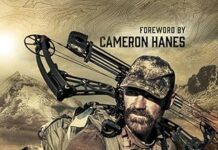
A really big Idaho buck from 2012 I found while scouting. This was the only look I got at him in a week of searching. My mistake? I spooked him while scouting.
I wouldn’t say scouting for mule deer is a technical undertaking- just find the country bucks call home and spend some time there. However, I think there is more than just showing up. We have to scout like we’d hunt: carefully. Scouting is worthless if you’re only bumping bucks you plan to hunt. While the younger bucks might let you get away with it, I’ve found that once a buck reaches about five years old, he won’t put up with humans. He’ll just leave the immediate area and hide, often for the season.
I put together a video for you all to show you a typical scouting trip. I worry I might bore you, but scouting can be awfully boring, too. Days are long and deer are only active less than a few hours at this time of year. However, I get enough questions that I thought some of you might benefit if I took you along.
My company, WeScout4u.com, has scouted Western Wyoming for 20+ years. Recently I took a trip to some country where I’ve seen good bucks over the decades. While it might just be another “floating-talking” head video, I’m pretty sure some of the tips I give will benefit even the most experienced mule deer hunters among us. The video is less than 15 mintues, so kick up your feet and take a gander.




















Great video, I got a lot out of it. I would like to see some more of your scouting trips, particularly Idaho;)
It’s amazing how little time those Bucks spend being visible in the summer. The whole scouting trip usually comes down to a 10 minute window in the morning and then they disappear for the rest of the day. The swirling wind this time of year makes it hard to sneak in sometimes too.
I just got back from a short trip and saw a lot of deer tracks and browse sign from Does and Fawns on the lower ridge I was on. In my experience the Bucks are sometimes close by but higher on the mountain. What do you think?
“Best thing about scouting…..spending time in God’s country!”
Love it!
Ron, it depends on the area. If you’re seeing lots of does/fawns, I’d move on. Look for steeper, rougher country. As you said, probably just higher as long as the ridges you mention are buck country. There’s one place in SE Idaho that looks so good for bucks, pretty rough, lots of aspen/conifer/sage and not easily accessible. I finally gave up looking for bucks there. It only holds does/fawns (until the November rut). Just a mile to the east and less than 1,000 feet higher is where I find the bucks. Can’t explain why. That is why we scout.
And Jason- Amen! Never really a bad scouting trip if you can keep that perspective.
Loved the video Robby thanks for taking the time! It seems that the few scouting trips I’ve been on this summer that the deer/bucks were much more active in the evening hours rather than first light. I think it’s because with it being so warm out they’re likely out feeding a lot at night and hit their beds first thing in the morning but when evening rolls around they’re a bit more anxious to get up and feeds and it seems like the last 20 minutes have produced more deer and more bucks than the first 20 minutes of light. Any thoughts on this? It’s just something I’ve noticed about summer behavior that seems to vary from the fall/winter patterns I see in the deer I hunt.
Mike, hard to say with just a few trips into an area as temp, moon phase, and conditions we can’t even perceive affect them. That is why you just gotta scout. There are no formulas but hard work. Also, I looked at those pics you sent. Bucky, bucky. I think if you’ll just learn the area and focus there, you’ll do fine. Should be more than a few 5+ year old bucks living there. Keep us posted.
awesome video robby thanks for taking the time to share some of your tips even if we all know how to scout we all can be helped from reminders and take some new tips from other people. I learn everyday weather I am at work or at play.
Comments are closed.